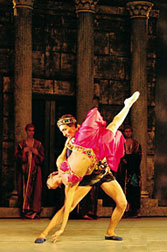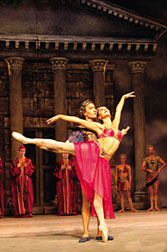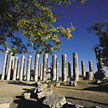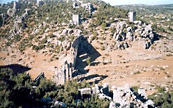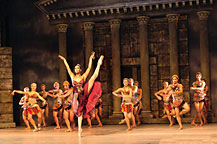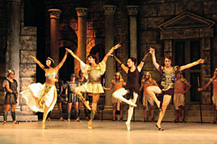|

Autumn
2005 (13.3)
Pages
20-23
Queen Aba
Another Masterful Orchestral Work by Farhang Huseinov
by
Betty Blair
All ballet photos by Selami Turk
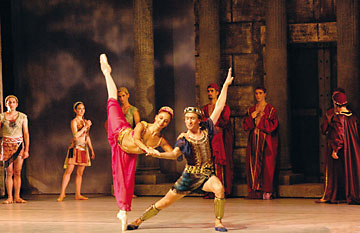 
Queen Aba (Ozlem Shenormanlilar) with
Teukros King of Olba (Ender Uchdemir).
Photo by Selami Turk.
He's at it again.
Azerbaijani composer Farhang Huseinov (1949- ) has written another
masterful orchestral work - again based on a socio - cultural
theme set outside the borders of Azerbaijan.
The inspiration for
this new ballet called Queen Aba are the historical and archaeological
roots that date back 2,000 years ago to Queen Aba of Cilicia
(ancient name of Southern Turkey) and Mark Anthony (Emperor of
Rome) and Cleopatra (Queen of Egypt).
The setting takes place in the
Olba Kingdom (near Mersin, Turkey, on the Mediterranean Sea).
At that time this region was paying taxes to the Roman Empire.
When King Teukros of Olban married Aba and made her queen, he
was not aware that in earlier years she had been a female warrior.
Enter Mark Anthony who presents his lover Cleopatra Queen of
Egypt with the Olba kingdom as gift. Pompey, the Roman general
objects since Cleopatra is Egyptian and he attacks the region.
But Queen Aba comes to Cleopatra's rescue and, in return, Cleopatra
returns the Olban Kingdom to her. Queen Aba succeeds in liberating
the Olban Kingdom from the Roman Empire and then continues to
rule after her husband's death.
Above: Exquisite performance of Queen Aba
and Teukros, King of Olba (Ender Uchdemir) who marries her. Photo:
Selami Turk.
  Even
the Greek historian Strabo (born 63 BC and who died after 21
AD) mentions Queen Aba in his well-known Geographia. Many archaeological
ruins can still be seen in this region today showing what an
advanced civilization existed at that time in the region of southern
Turkey. Even
the Greek historian Strabo (born 63 BC and who died after 21
AD) mentions Queen Aba in his well-known Geographia. Many archaeological
ruins can still be seen in this region today showing what an
advanced civilization existed at that time in the region of southern
Turkey.
The Queen Aba Ballet
premiered on October 13, 2005, at the Mersin State Opera and
Ballet Theater under the auspices of the Turkish Ministry of
Culture. The production included more than 150 performers, including
70 musicians in the orchestra, 40 dancers and 40 members of the
chorus.
The libretto was written by
Altay Bayram in 2001 and was choreographed by Ali Hoja and features
the following dancers: Ozlem Shenormanlilar (Aba, Queen of Olba),
Ender Uchdemir (Teukros, King of Olba), Victoria Haylova (Cleopatra,
Queen of Egypt), Ulvi Azizov (Anthony, Emperor of Rome), Mahmut
Akyol (Head Priest of Olba) and Zihnibek Ussin (Pompey, Roman
General).
Above: Roman General Pompey (Zihnibek Ussin)
attacks. Photo by Selami Turk.
Though independence is one of the main themes running through
the ballet, more importantly for Huseinov is the illustrious
example of Aba as a woman who used her ingenuity, wisdom and
diplomatic skills to lead her nation. As Huseinov likes to say:
"It happened not 20 years ago, nor 200, but 2,000 years
ago!
Above left to
right:
Archaeological
scenes in Turkey:
1. Archaeological ruins of Olba, at least 2,000 years old.
2. Temple of Zeus Olbius which inspired the stage setting for
the ballet.
3. Archaeological ruins of Olba.
  Under the guidance of the Mersin University
Archaeology Department, Altay Bayram pieced together aspects
of the story that had previously been unknown and created the
story line for a dramatic work based on Olban culture, which
is Anatolian and based on Hittite culture, along with Roman and
Egyptian cultures. Under the guidance of the Mersin University
Archaeology Department, Altay Bayram pieced together aspects
of the story that had previously been unknown and created the
story line for a dramatic work based on Olban culture, which
is Anatolian and based on Hittite culture, along with Roman and
Egyptian cultures.
"One of the most
significant aspects about this ballet," says composer Huseinov,
"is that viewers can still visit Aba's tomb and see the
archaeological ruins of the settlement where the story actual
took place. You can go and walk in the same valley and touch
the same walls that Aba did 2,000 years ago. What an incredible
feeling!"
Above: Tomb of Queen Aba, Canytella, Turkey.

Above: Archaeological relief: The Thousand
Gods of the Hittites. The people of Olba were descended from
teh Hittites.
  Musical Background Musical Background
Farhang Huseinov studied violin with Karp Dombayev and composition
with Gara Garayev at the Azerbaijan State Conservatory (now Academy)
from 1969-1971.
Then he continued his
studies at the Moscow Conservatory where he studied Violin with
Leonid Kogan and Composition with Aram Khachaturian.
Above: Relief of Queen Aba at Canytella, Turkey.
Upon graduating in 1975, he worked as Kogan's assistant until
1978, when he returned to Baku to teach Violin at the Azerbaijan
State Conservatory.
Since 1992 Huseinov has lived in Turkey and been teaching at
Jukurova University State Conservatory in Adana, Turkey, where
he serves as Chair of the String Department. For the past three
years, he has also offered music courses in Haifa, Israel.
Above left: Scene from the Queen Aba Ballet performed
by the ballerina Ozlem Shenormanlilar.
Right: Cleopatra, Queen of Egypt (Victoria
Haylova) Dances with Mark Anthony Emperor of Rome (Ulvi Azizov).
Photos by Selami Turk.
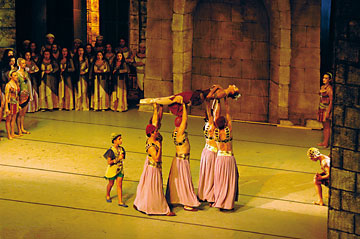
Above: Death scene of Queen Aba. Photo: Selami
Turk.
Huseinov has won numerous awards
for his musical compositions including two prizes from the United
Nations for his musical works - an Oratorio "May Peace Prevail
on the Earth" and "Stabat Mater" for Soprano and
String Quartet.
In 2001, he took First Prize
for "Capriccio Guarani" at the First Jose Asuncion
Flores International Composition Contest in Paraguay. This work
incorporates folk melodies, not only from Paraguay, but also
from China, Japan, Mongolia, Korea and Alaska.
Below: Finale of Ballet. More than 150 artists
were involved in performing the ballet, including ballet dancers,
musiciians in th eorchestra and members of the chorus.
Photo: Selami Turk.
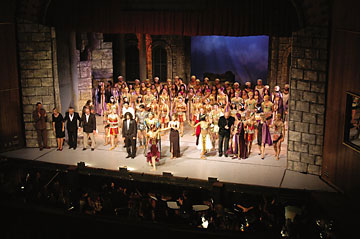  In 1991 Huseinov won
a prize in the Japanese Silk Road Competition for his "Concerto
for Orchestra: In 1991 Huseinov won
a prize in the Japanese Silk Road Competition for his "Concerto
for Orchestra:
Traveling Through Time" which led to a commission for the
opera, Kodayu (1993), which based on a Japanese sailor's adventures
in 18th century Russia.Further evidence of Huseinov's popularity
in Japan can be seen in the commission that he received in 2001
from Japanese conductor Yoshinao Osawa to write a work for the
Tokyo Symphony.
Editor's Note: Farhang Huseinov, born 1949, passed away in 2010.
Read more: Farhang Huseinov wins Asuncion Prize in Paraguay, 2001.
Back to Index AI 13.3 (Autumn
2005)
AI Home
| Search | Magazine
Choice
| Topics
| AI Store | Contact us
Other Web sites
created by Azerbaijan International
AZgallery.org | AZERI.org | HAJIBEYOV.com
|


